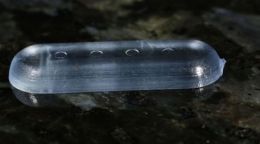Yorkshire engineers develop first integrated 3D barcode
It is estimated that the value of fake products sold worldwide could be as high as $1.8 trillion per year. However, a team of engineers from Bradford University have collaborated with UK SME, Sofmat to create the first 3D integrated barcode, which could significantly help in the fight against counterfeit goods.

It is estimated that the value of fake products sold worldwide could be as high as $1.8 trillion per year. However, a team of engineers from Bradford University have collaborated with UK SME, Sofmat to create the first 3D integrated barcode, which could significantly help in the fight against counterfeit goods.
Unlike most existing anti-counterfeit devices which are usually added to the product or its packaging after manufacture, the new barcode is integrated into the product itself, making it much harder to replicate.
The barcode is read by a laser scanner to track or authenticate the product. It is invisible to the touch and can barely be seen with the naked eye. There are over 1.7 million different configurations of the code, which is made up of tiny indentations in the surface of the product, created by pins which are integrated into its mould. The prototype, developed with funding from Innovate UK, works with a four pin array. Using micro actuators, the pins can be set at different heights, each step corresponding to either a letter (A-Z) or a number (0-9).
Dr Ben Whiteside, from Bradford University explains; “The system enables very small displacements to be made in each pin – each step being just 0.4microns, 100th of the width of a human hair. These have to be set with a very high accuracy and with sufficient force so their position is maintained during the manufacturing process. While our system has been developed initially for products made from plastics or composites through injection moulding, it could also be used to stamp or emboss the code onto a product.”
“A 3D barcode allows much more complexity than existing anti-counterfeit systems,” said Sofmat Director Dr Phil Harrison. “You can have multiple configurations, different codes on each individual product and additional details such as patterns on the heads of the pins themselves, making copying the code extremely difficult. For the first time the same technology and coding can be used on bulk packaging, individual packaging and on the actual product, making it much harder to create and ship fake products.”
The team feel that the technology is particularly suited to the pharmaceutical and automotive industries, as well as for high value consumer products.
At present a laser scanner is in development that will be able to read the code and wirelessly transmit the result via an app to either a phone or tablet. Successful laboratory testing has so far used a white light interferometer and a laser-scanning confocal microscope to characterise the surface of the coded ‘product’ to ensure the code is accurately reproduced.
Watch the University of Bradford’s video for a further explanation:
